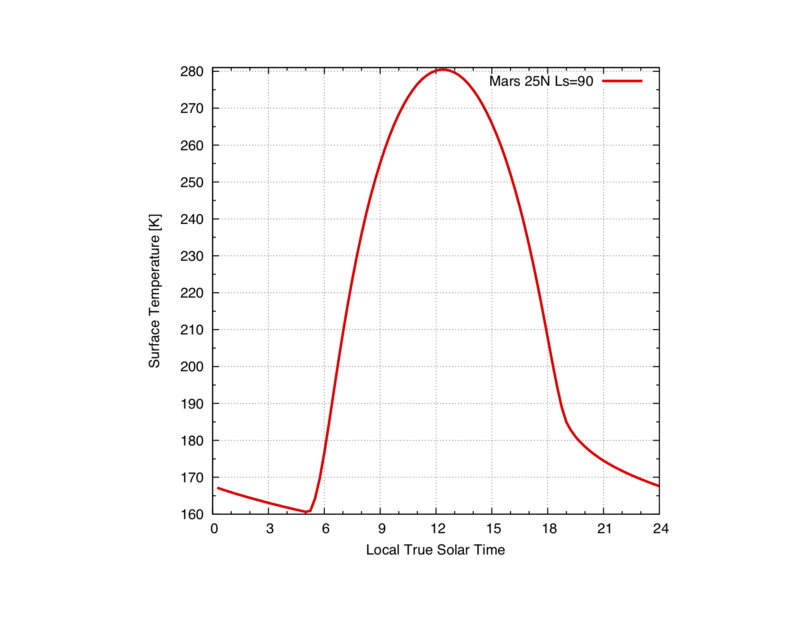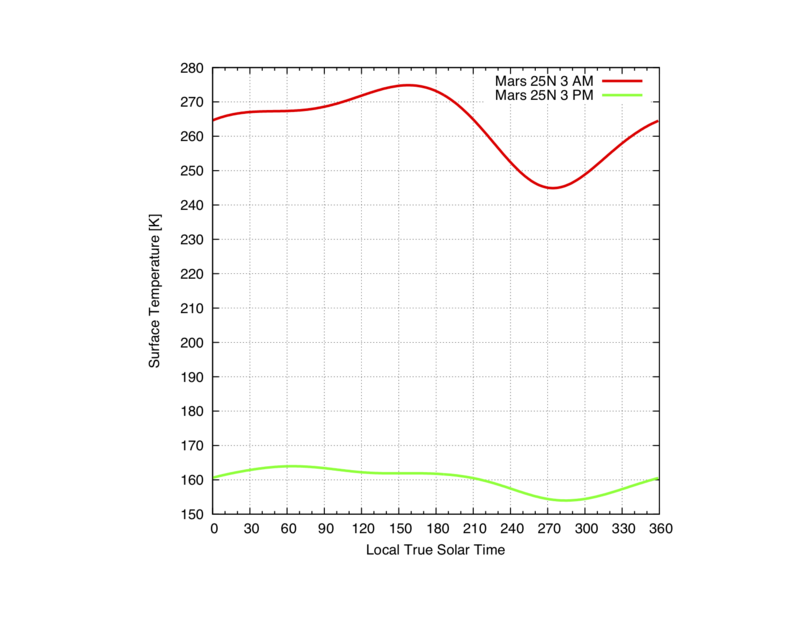KRC for Mars
(→Notes) |
(→Running in the Command Line) |
||
| (3 intermediate revisions by one user not shown) | |||
| Line 13: | Line 13: | ||
For Mars, it can be run with as little input as a single latitude, e.g. 25°N: | For Mars, it can be run with as little input as a single latitude, e.g. 25°N: | ||
| − | + | OUT = krc(lat=25.) | |
Model output is saved in structure 'OUT'. The decimal is required for parameters to be initialized as a floating point number. All other model inputs are retrieved from lookup tables (e.g., longitude, surface albedo, thermal inertia etc.). | Model output is saved in structure 'OUT'. The decimal is required for parameters to be initialized as a floating point number. All other model inputs are retrieved from lookup tables (e.g., longitude, surface albedo, thermal inertia etc.). | ||
| Line 23: | Line 23: | ||
Additional fields can be prescribed within the parentheses when calling krc. E.g., the same latitude but for a longitude of 120° and surface albedo of 0.3: | Additional fields can be prescribed within the parentheses when calling krc. E.g., the same latitude but for a longitude of 120° and surface albedo of 0.3: | ||
| − | + | OUT = krc(lat=25.,lon=120.,ALBEDO=0.3) | |
If a particular season provided as solar longitude (in units of degrees) is desired, the annual dimension (e.g., 360) is removed. E.g., for Ls = 90° (northern summer solstice): | If a particular season provided as solar longitude (in units of degrees) is desired, the annual dimension (e.g., 360) is removed. E.g., for Ls = 90° (northern summer solstice): | ||
| − | + | OUT = krc(lat=25.,ls=90.) | |
| + | |||
| + | Alternatively, the model can run for a specific Gregorian Date, (currently ranging from 1990-Jan-01 to 2040-Jan-01, format: ????-Mmm-DD, | ||
| + | with Mmm:Jan, Feb, Mar, Apr, May, Jun, Jul, Aug, Sep, Oct, Nov, Dec | ||
| + | |||
| + | OUT = krc(lat=12.,GD="2010-Jan-05") | ||
| + | |||
| + | or a specific Julian Date: | ||
| + | |||
| + | OUT = krc(lat=12.,JD=2455201) | ||
| + | |||
| + | Note: the possibility to specify the date with GD is only currently available for Mars, the Moon, Bennu, and Europa. | ||
Now 'OUT.tsurf' has the dimensions of: | Now 'OUT.tsurf' has the dimensions of: | ||
| Line 35: | Line 46: | ||
One can plot the diurnal temperature series against local true solar time (LTST) with: | One can plot the diurnal temperature series against local true solar time (LTST) with: | ||
| − | + | plot(OUT.tsurf,xaxis=OUT.time,"25N,Ls=90",w=4 ,color=1) | |
| − | + | labelxy("LTST","Temperature (K)") | |
[[Image:mars_temp_1.png|border|800px]] | [[Image:mars_temp_1.png|border|800px]] | ||
| Line 42: | Line 53: | ||
Alternatively, one can prescribe local time and output will be provided for a full Mars year, e.g., for a local time of 3 AM: | Alternatively, one can prescribe local time and output will be provided for a full Mars year, e.g., for a local time of 3 AM: | ||
| − | + | OUT = krc(lat=25.,hour=3.) | |
'OUT.tsurf' will now be sampled roughly once per degree of solar longitude, e.g.,: | 'OUT.tsurf' will now be sampled roughly once per degree of solar longitude, e.g.,: | ||
| Line 50: | Line 61: | ||
And can be plotted against time (with the addition of 3PM local time as 'OUT_2') with: | And can be plotted against time (with the addition of 3PM local time as 'OUT_2') with: | ||
| − | + | plot(OUT.tsurf[12,1,],w=4,color=4,"Dawn",OUT.tsurf[60,1,],w=4,color=1,"Noon") | |
| − | + | labelxy("Solar Longitude","Temperature (K)") | |
[[Image:mars_temp_2.png|border|800px]] | [[Image:mars_temp_2.png|border|800px]] | ||
Latest revision as of 16:16, 9 April 2020
Contents |
[edit] Notes
Basalt is the default material for Mars (Mat1 = "basalt"), and T_user = 220 (temperature at which the inertia is defined).
By default, PTOTAL = 545 Pa.
[edit] Running in the Command Line
KRC is run within Davinci.
> davinci
For Mars, it can be run with as little input as a single latitude, e.g. 25°N:
OUT = krc(lat=25.)
Model output is saved in structure 'OUT'. The decimal is required for parameters to be initialized as a floating point number. All other model inputs are retrieved from lookup tables (e.g., longitude, surface albedo, thermal inertia etc.).
By default, the output is stored into multidimensional arrays sampled at 96 values per sol and 360 values per Mars year. Hence the structure element surface temperature ('OUT.tsurf') appears as:
tsurf: 96x1x360 array of double, bsq format [276,480 bytes]
Additional fields can be prescribed within the parentheses when calling krc. E.g., the same latitude but for a longitude of 120° and surface albedo of 0.3:
OUT = krc(lat=25.,lon=120.,ALBEDO=0.3)
If a particular season provided as solar longitude (in units of degrees) is desired, the annual dimension (e.g., 360) is removed. E.g., for Ls = 90° (northern summer solstice):
OUT = krc(lat=25.,ls=90.)
Alternatively, the model can run for a specific Gregorian Date, (currently ranging from 1990-Jan-01 to 2040-Jan-01, format: ????-Mmm-DD, with Mmm:Jan, Feb, Mar, Apr, May, Jun, Jul, Aug, Sep, Oct, Nov, Dec
OUT = krc(lat=12.,GD="2010-Jan-05")
or a specific Julian Date:
OUT = krc(lat=12.,JD=2455201)
Note: the possibility to specify the date with GD is only currently available for Mars, the Moon, Bennu, and Europa.
Now 'OUT.tsurf' has the dimensions of:
tsurf: 96x1x1 array of double, bsq format [768 bytes]
One can plot the diurnal temperature series against local true solar time (LTST) with:
plot(OUT.tsurf,xaxis=OUT.time,"25N,Ls=90",w=4 ,color=1)
labelxy("LTST","Temperature (K)")
Alternatively, one can prescribe local time and output will be provided for a full Mars year, e.g., for a local time of 3 AM:
OUT = krc(lat=25.,hour=3.)
'OUT.tsurf' will now be sampled roughly once per degree of solar longitude, e.g.,:
tsurf: 1x1x360 array of double, bsq format [2,880 bytes]
And can be plotted against time (with the addition of 3PM local time as 'OUT_2') with:
plot(OUT.tsurf[12,1,],w=4,color=4,"Dawn",OUT.tsurf[60,1,],w=4,color=1,"Noon")
labelxy("Solar Longitude","Temperature (K)")
[edit] Table of Input Parameters
Other common fields that can be prescribed are included in the table below (*NOTE fields are case sensitive*): [table of parameters (include example ranges?)]
| Parameter | KRC Syntax | Range | Units |
| Latitude | lat | -90–90 | |
| Longitude (°E) | lon | 0–360 | |
| Albedo | ALBEDO | 0–1 | |
| Thermal Inertia | INERTIA | 20–2000 | |
| Elevation | ELEV | ||
| Local True Solar Time | hour | 0–24 | |
| Solar Longitude | ls | 0–360 | |
| Local True Solar Time | hour |
[edit] Deriving Thermal Inertia and the Simulated One Point Mode
In order to derive thermal inertia values for a single temperature measurement one can use the simulated one-point mode in KRC. *available only for Mars at present
Please refer to the Simulated One Point Mode page for more information.

